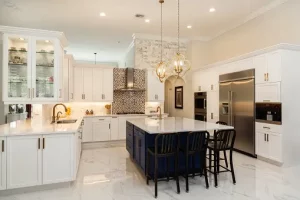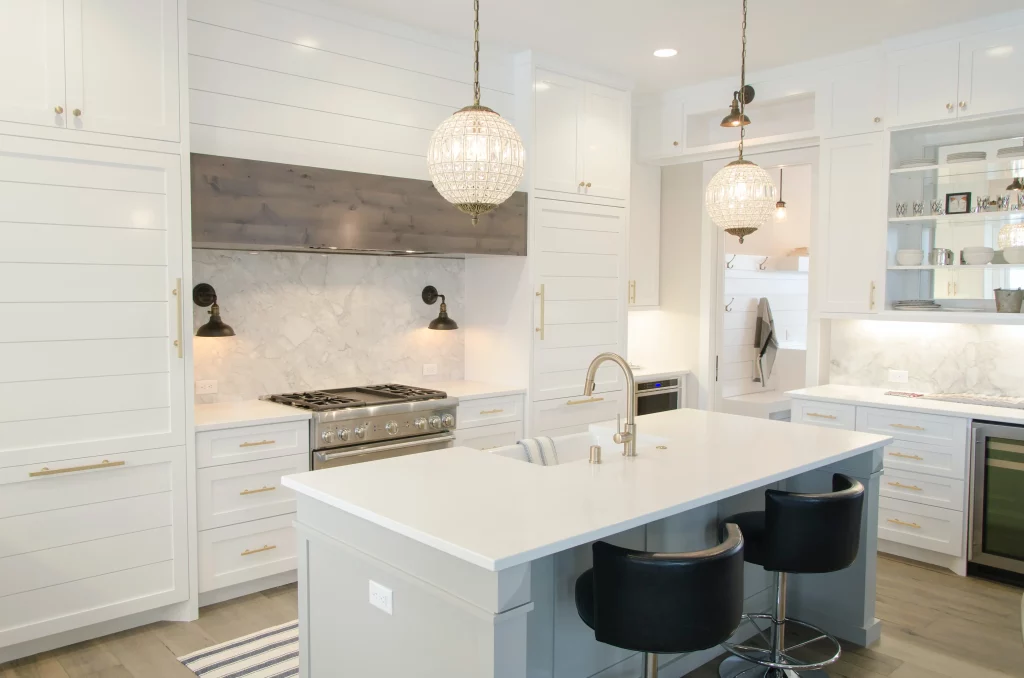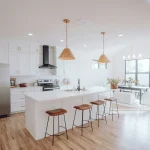Welcome to the world of open-concept small kitchen remodels. This transformative journey will take you from traditional layouts to modern, open-plan designs. We’ll explore the trend, its advantages, and how it can increase your property’s value. Discover how to integrate your living room with your kitchen, position your appliances, and even where to place your TV.
Despite the popularity of open-concept kitchens, they do have their downsides. So, let’s dive in and uncover the secrets of creating a harmonious, functional, and stylish open-concept small kitchen. Ready to embark on this exciting adventure?
Exploring the Open Concept Kitchen Trend
Open concept kitchens became increasingly popular in recent years. They are characterized by their spacious layout, seamless flow, and inclusive design. Let’s delve deeper into this trend:
Understanding Open Concept Kitchens
An open concept kitchen is a part of a larger living space that includes the dining and living areas. It eliminates walls and barriers to create a single, unified space. This design encourages social interaction, enhances natural light, and creates a sense of spaciousness.
The Rise of Open Concept Kitchens
The trend of open concept kitchens has its roots in the mid-20th century, when architects started designing homes with more flexible and interactive spaces. Today, it’s a common feature in modern homes and renovations. Its popularity is driven by the shift towards more casual living and entertaining styles.
Open Concept Kitchens and Style
Open concept kitchens can accommodate various styles, from rustic to contemporary. The key is to maintain a cohesive design throughout the space. Elements like flooring, color schemes, and lighting should complement each other and create a harmonious look.
The Role of Kitchen Islands
In many open concept kitchens, the island serves as a focal point. It provides additional workspace, storage, and seating. It also helps to define the kitchen area within the open space.
The Future of Open Concept Kitchens
While trends come and go, the open concept kitchen seems to have staying power. Its ability to facilitate a flexible, interactive, and inclusive living environment resonates with many homeowners.
Designing a Small Kitchen: Layout and Color Choices
Designing a small kitchen can be a hard yet profitable task. The key to a a hit design lies within the format and shade alternatives.
Layout
The layout is backbone of your kitchen design. It determines without difficulty you could circulate round and how effectively you could use the gap. For small kitchens, the best layouts are commonly the one-wall, galley, or L-formed designs. These layouts make the best use of limited space, providing ample storage and work areas without making the kitchen feel cramped.
- One-Wall Layout: This format is ideal for terribly small areas. All the shelves and home equipment are coated up on one wall, leaving the rest of the distance open. This layout is simple, practical, and value-effective.
- Galley Layout: Named after the compact kitchens on ships, the galley layout features two parallel runs of units. This layout is efficient but can feel a bit closed off. An open-concept galley layout can help alleviate this issue.
- L-Shaped Layout: This layout utilizes two adjacent walls, forming an “L” shape. It’s a versatile layout that works well in both small and large kitchens.
Color Choices
Color performs a crucial position in growing the phantasm of area. Light colorings, together with white, cream, or pastel sunglasses, are known to make a room seem larger and brighter. They reflect light, enhancing the sense of space. Using a monochromatic color scheme can also create a seamless look that doesn’t visually break up the space.
Transforming a Traditional Kitchen into an Open Concept Space
Transitioning from a conventional kitchen to an open concept space may be a recreation-changer for your house. It not best creates a feel of spaciousness however additionally complements the flow of your residing location. Here’s how you can achieve this transformation:
Planning the Layout
The first step in creating an open concept kitchen is planning the layout. You want to recall the placement of your home equipment, garage regions, and seating. The aim is to create a purposeful area that seamlessly integrates with the relaxation of your own home.
Removing Walls
In many cases, transforming a traditional kitchen into an open concept space involves removing walls. This should always be done by a professional, as there could be electrical wiring or plumbing hidden within the walls. Also, some walls may be load-bearing and removing them could compromise the structural integrity of your home.
Reconfiguring Spaces
Once the walls are removed, you’ll need to reconfigure your space. This might involve moving appliances and rerouting plumbing. It’s important to think about how you use your kitchen and what layout will best suit your needs.
Creating a Cohesive Design
An open concept kitchen should blend seamlessly with the rest of your living area. This means you’ll need to think about how the design and decor of your kitchen will complement the rest of your home. Consider elements like flooring, color schemes, and lighting.
Adding an Island
If space allows, adding an island to your open concept kitchen can be a great idea. It provides extra storage, a place for seating, and additional workspace. Plus, it can act as a focal point in your kitchen.
The Art of Positioning Appliances in a Small Kitchen
In a small kitchen, the placement of appliances can make a significant difference in functionality and aesthetics. Here’s how you can strategically position your appliances in a small kitchen:

Fridge Placement
The refrigerator is one of largest appliances in the kitchen and placement is crucial. It will be position in a place that does not obstruct flow of traffic. A common practice is to place it near the kitchen’s entrance, so it’s easily accessible.
Stove and Sink Placement
The stove and sink are the most used areas in a kitchen. They should be placed in a way that makes cooking and cleaning efficient. The concept of the kitchen work triangle – the optimal distance between the stove, sink, and refrigerator – can be a helpful guide.
Small Appliance Storage
Small appliances like microwaves, toasters, and coffee makers need to be accessible but shouldn’t clutter the countertop. Consider dedicating a specific cabinet or shelf for these appliances.
Dishwasher Placement
If your kitchen dishwasher it will ideally be placed next to the sink for easy loading and unloading.
Ventilation
Proper ventilation is essential in a small kitchen to keep the air fresh and remove excess heat. The range hood should be placed directly above the stove.
Remember, every kitchen is unique, and what works for one might not work for another. It’s important to consider your specific needs and habits when positioning your appliances.
Creating Harmony: Integrating the Living Room with an Open Kitchen
Creating a harmonious space that integrates the living room with an open kitchen can be a rewarding endeavor. Here’s how you can achieve this:
Consistent Design Elements
To create a seamless look between your kitchen and living room, use consistent design elements. This could include similar color schemes, matching flooring, or complementary furniture styles.
Functional Zoning
Even in an open concept space, it’s important to define different zones for cooking, dining, and relaxing. Rugs, lighting, and furniture placement can help delineate these areas without the need for walls.
Furniture Placement
The way you arrange your furniture can greatly impact the flow of your space. Try to position your furniture in a way that encourages conversation and interaction. For instance, facing your sofas towards each other creates a cozy, conversational area.
Lighting
Lighting plays a crucial role in creating a harmonious space. Use mix ambient, task and accent lighting for creating warm and inviting atmosphere. Remember to consider natural light as well.
Decorative Elements
Decorative elements like artwork, plants, and accessories can help tie your kitchen and living room together. Pieces reflect your personal style and creating cohesive look to chose.
Remember, the goal is to create a space that feels unified yet functional. With careful planning and thoughtful design, you can create a beautiful open concept kitchen and living room that you’ll love spending time in.
TV Placement in an Open-Concept Living Room
In an open-concept living room, the placement of the TV can significantly impact the overall aesthetics and functionality of the space. Here’s how you can strategically position your TV:
Wall Selection
It should be a wall that allows comfortable viewing from different areas – the kitchen, dining area, and living area. Avoid walls that face windows to prevent glare.
Centering the TV
The TV doesn’t always have to be in the center of the wall. Instead, consider the balance of the room. If your seating is off to one side, it might make sense to place the TV off-center.
Viewing Height
The height at which the TV is placed is important for comfortable viewing. The middle of the screen should be at eye level when seated. This might be lower than you’d expect!
Creating a Focal Point
In many living rooms, the TV is the focal point. In an open-concept space you might want to create additional focal points to draw the eye. This could be a piece of artwork, a feature wall or unique piece of furniture.
Concealing the TV
If you don’t want the TV to dominate your space, consider creative ways to conceal it. This could be using a TV cabinet with doors, a motorized lift, or even a pull-down art screen.
Strategies for Separating the Kitchen, Dining, and Living Areas
In an open-concept layout, defining separate zones for the kitchen, dining, and living areas can help maintain functionality while preserving the open feel. Here’s how you can achieve this:
Use of Rugs
Rugs are a simple and effective way to define different zones. A large area rug can anchor the living room furniture, while a smaller one can define the dining area.
Lighting
Different lighting can create distinct atmospheres in each zone. For example, pendant lights over the dining table can create a focused, intimate space, while softer, ambient lighting can make the living area feel cozy and relaxed.
Furniture Arrangement
The way you arrange your furniture can also define different zones. For instance, positioning your sofa with its back to the dining area can create a clear division between the living and dining zones.
Color Schemes
Using different but complementary color schemes can help distinguish each area. This could be as simple as having different colored cushions in the living area, or using different wall colors.
Room Dividers
Room dividers such as open shelving units or screens can create a visual separation without blocking light or views. They also provide additional storage or display space.
Determining the Ideal Size for an Open Plan Kitchen-Living Room
The size of an open plan kitchen-living room depends on several factors including the overall size of your home. It is function of space and your personal preferences. Here is how you can determine the ideal size for your open plan kitchen-living room:
Assess Your Space
Start by assessing the total area you have available. This will give you a clear idea of how much space you can allocate to your open plan kitchen-living room.
Define Your Needs
Or do you prefer a larger living area for entertaining? Your lifestyle and needs will significantly influence the size of your open plan kitchen-living room.
Consider the Flow
The flow of the space is crucial in an open plan layout. Ensure there’s enough room to move comfortably between different areas. For example, there should be ample space between the kitchen island and the dining table.
Balance Proportions
It’s important to balance the proportions of the kitchen and living room. Neither area should overpower the other. A well-balanced space is pleasing to the eye and creates a harmonious feel.
Consult a Professional
If you’re unsure, it can be helpful to consult a professional. An interior designer or architect can provide valuable insights and help you determine the ideal size for your open plan kitchen-living room.
Understanding Pros and Cons of Open Plan Kitchens
Open plan kitchens are a popular choice in many homes due to their ability to create a spacious inclusive and sociable environment. Like any design choice come with their own set of advantages and disadvantages.
Advantages
- Spaciousness: Open plan kitchens make a home feel larger and more spacious. By removing walls you eliminate barriers that can make a space feel cramped.
- Light: Without walls to block it, natural light can flow freely through an open-plan space, making it brighter and more inviting.
- Sociability: An open-plan kitchen allows for easy interaction between family members or guests, making it an ideal layout for those who enjoy entertaining.
- Versatility: Open-plan kitchens are flexible spaces that can be easily adapted to suit different activities, from cooking and dining to relaxing or entertaining.
Disadvantages
- Noise: Without walls to contain it, noise can easily travel through an open-plan space. This can be a disadvantage if different activities are happening simultaneously, such as cooking and watching television.
- Smell: Cooking odors can spread throughout the open-plan space, which some people may find unpleasant.
- Lack of Privacy: Open-plan kitchens offer less privacy than traditional layouts. This might not be ideal for those who prefer to cook without being disturbed or watched.
- Heating and Cooling: Open spaces can be more challenging to heat or cool efficiently, potentially leading to higher energy costs.
The Impact of Open Concept Designs on Property Value
Open concept designs have become a popular trend in home remodeling and new construction. But how do these designs impact property value? Let’s explore:
Increased Perceived Space
Open concept designs can make a home feel larger and more spacious, even if the square footage remains the same. This increased perceived space can be appealing to potential buyers and may increase the property’s value.
Modern Appeal
Open concept designs are often associated with modern, contemporary homes. This style can attract buyers who prefer a modern aesthetic, potentially increasing demand and property value.
Improved Natural Light
By removing walls and barriers, open concept designs allow for better natural light distribution. Homes with good natural light are often more appealing to buyers, which can positively impact property value.
Flexibility
The flexibility of open concept designs can also add value. These spaces can be easily adapted to suit a buyer’s specific needs, whether they need a large entertaining space or a cozy family area.
It is important to note that while open concept designs can increase property value, they may not appeal to every buyer. Some people may prefer traditional layouts with separate rooms for different functions. Therefore, it’s crucial to consider your target market and the potential return on investment before undertaking a significant remodeling project like converting to an open concept design.
Conclusion
Open concept small kitchen remodels can transform your home, creating a spacious, modern, and sociable environment. From planning the layout to choosing color schemes, positioning appliances, and integrating the living room, every step plays a crucial role in the transformation. Open concept kitchens offer numerous benefits. They come with their set of challenges.







